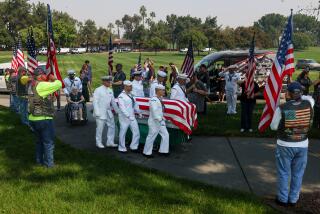Civil War Sailors Beckon From the Grave
- Share via
BUXTON, N.C. — It has whispered through the sea oats of North Carolina’s Outer Banks for more than a century--a legend about five sailors from the shipwrecked ironclad USS Monitor, another unproven footnote to Hatteras Island’s Civil War past.
Mel Covey hopes to change that.
Covey, 42, has spent 27 years combing National Park Service archives, military records, maps and deeds, looking for clues to the sailors’ burial site.
“We’re talking about the most famous warship in U.S. naval history,” he says. “They were an all-volunteer crew, in a ship deemed not seaworthy, going to a battle they had no chance of winning. And they’re buried on what essentially is foreign soil.”
Four officers and 12 crewmen aboard the 49-man ship died when the Monitor sank in a gale off Cape Hatteras on Dec. 31, 1862. The wreck was found in 1973.
The Monitor, which marked the beginning of the transition from wooden to metal warships, revolutionized naval warfare with its armored hull and revolving turret guns. In an epic battle on March 9, 1862, the Monitor battled to a draw in Virginia’s Hampton Roads Harbor with the Confederate armored ship Virginia, also known as the Merrimack.
The search for the sailors’ graves coincides with an expedition under way off Cape Hatteras to save physical remnants of the Monitor from oblivion at the bottom of the Atlantic Ocean. Last month, the Monitor’s 10-foot propeller well cover and a deck plate were recovered by researchers documenting the condition of the sunken vessel.
Covey thought a dig in March would uncover the graves. Local volunteers and experts from East Carolina University in Greenville began a search under rocks left from a lighthouse demolished when the current Cape Hatteras Lighthouse was lit in December 1870. Covey believes the rocks were grave markers.
But after five days, the volunteers found only rusted barbed wire, posts, metal pails, jars and bottles. The crew hit water 11 feet down. Weeks later, Covey refused to give up.
“I know they’re here,” he says. “I can’t accept failure.”
Covey’s interest in the grave site dates to his days working for a school historical publication and an assignment to photograph the site. At that time, he says, the National Park Service had marked the area as the “suspected site” of the sailors’ grave.
The legend is fed by the writings of Ben Dixon MacNeill in his 1958 book, “The Hatterasman.” He wrote that federal troops marked the grave site with stones from the old lighthouse.
“The stones lay there, embedded in the earth, until I stumbled over the topmost one on a winter’s day 90 years later,” MacNeill wrote. “Nearby was, and is, the stump of a massive cedar tree and, in 1863, its branches must have hidden whatever was under it.”
The cedar stump remains, separated from the site excavated in March by a path the Park Service built in 1960. MacNeill is the only written source for the legend, according to David Phelps, director of ECU’s coastal archeology office.
“But the legend has always been there,” Phelps says. “There’s no other reason for two tons of granite rocks to be there.”
Phelps hopes to get a permit extension from the Park Service to dig closer to the cedar tree this fall.
The Park Service would probably allow a dig to seek out the graves but is unlikely to authorize exhumation of any remains, says Steve Harrison, chief of resource management for the Cape Hatteras National Seashore.
The pit was probably dug to build the nature trail, then filled with the junk the crew found in March, Phelps says. The rocks likely were moved either by MacNeill or perhaps when the trail was built, he says.
There’s also a hint in an 1888 deed that describes “a place known as the grave” as one of the property line’s reference points, near the lighthouse.
And there’s the matter of two men who, in a special census of Union Army survivors, claimed they joined on Jan. 3, 1863, the same day the five bodies supposedly washed ashore. Covey believes the men drove the wagon carrying the bodies and considered their Union service to have begun that day, although their records show their service entry dates to be Jan. 21 and in June of that year.
“Other than the Monitor, Jan. 3 is an unimportant date here,” Covey says. “Why did both of these guys insist they signed up Jan. 3?”
Like Covey, Phelps believes the grave is nearby.
“There’s no other reason for the rocks to be there,” he says. “And there’s no other reason for such strength of a local legend.”
More to Read
Sign up for Essential California
The most important California stories and recommendations in your inbox every morning.
You may occasionally receive promotional content from the Los Angeles Times.










